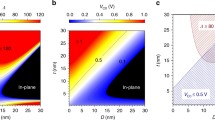Abstract
Magnetic tunnel junction can produce highly configurable molecular spintronics devices. This paper highlights a rather subtle attribute of magnetic tunnel junction fabrication that can lead to the very pronounced impact on magnetic properties of molecular spintronics device. We conducted magnetic studies to observe the effect of depositing ~5 nm Tantalum (Ta) on the top of a magnetic tunnel junction. We investigated the effect of Ta by using characterization techniques like ferromagnetic resonance, magnetometry, and polarized neutron reflectometry. Bridging paramagnetic molecules between the two ferromagnetic electrodes of magnetic tunnel junctions with and without Ta top layer produced the very different magnetic response.



Similar content being viewed by others
References
G.X. Miao, M. Munzenberg, and J.S. Moodera: Tunneling path toward spintronics. Rep. Prog. Phys. 74, 036501 (2011).
P. Tyagi: Multilayer edge molecular electronics devices: a review. J. Mater. Chem. 21, 4733 (2011).
P. Tyagi, E. Friebe, and C. Baker: Advantages of prefabricated tunnel junction based molecular spintronics devices. NANO 10, 1530002 (2015).
S. Yuasa and D. Djayaprawira: Giant tunnel magnetoresistance in magnetic tunnel junctions with a crystalline MgO (0 0 1) barrier. J. Phys. D: App. Phys. 40, R337 (2007).
S. Kezilebieke, M. Ali, B. Shadeke, and R. Gunnella: Magnetic properties of ultrathin Ni81Fe19 films with Ta and Ru capping layers. J. Phy.-Cond. Mat. 25, 476003 (2013).
M. Kowalewski, W.H. Butler, N. Moghadam, G.M. Stocks, T.C. Schulthess, K.J. Song, J.R. Thompson, A.S. Arrott, T. Zhu, J. Drewes, R.R. Katti, M.T. McClure, and O. Escorcia: The effect of Ta on the magnetic thickness of permalloy (Ni81Fe19) films. J. Appl. Phys. 87, 5732 (2000).
K. Baberschke: Magnetic anisotropy energy and interlayer exchange coupling in ultrathin ferromagnets: Experiment versus theory. Philos. Mag. 88, 2643 (2008).
J. Geshev, L.G. Pereira, and J.E. Schmidt: Dependence of the ferromagnetic resonance modes on the coupling strength in exchange-coupled trilayer structures. Physica B-Condens. Matter 320, 169 (2002).
J. Linder and K. Baberschke: Ferromagnetic resonance in coupled ultrathin films. J. Phys. -Condens. Matter 15, S465 (2003).
S.O. Demokritov: Biquadratic interlayer coupling in layered magnetic systems. J. Phys. D-Appl. Phys. 31, 925 (1998).
P. Tyagi, C. D’Angelo, and C. Baker: Monte Carlo and experimental magnetic studies of molecular spintronics devices. NANO 10, 1550056 (2015).
D.F. Li, S. Parkin, G.B. Wang, G.T. Yee, R. Clerac, W. Wernsdorfer, and S.M. Holmes: An S = 6 cyanide-bridged octanuclear (Fe4Ni4II)-Ni-III complex that exhibits slow relaxation of the magnetization. J. Am. Chem. Soc. 128, 4214 (2006).
P. Tyagi, C. Baker, and C. D’Angelo: Paramagnetic molecule induced strong antiferromagnetic exchange coupling on a magnetic tunnel junction based molecular spintronics device. Nanotechnology 26, 305602 (2015).
P. Tyagi, D.F. Li, S.M. Holmes, and B.J. Hinds: Molecular electrodes at the exposed edge of metal/insulator/metal trilayer structures. J. Am. Chem. Soc. 129, 4929 (2007).
Acknowledgments
Pawan Tyagi thank Dr. Bruce Hinds and Department of Chemical and Materials engineering at the University of Kentucky for facilitating experimental work on molecular spin-tronics during his Ph.D. OMC was produced by Dr. Stephen Holmes’s group. The preparation of this paper and complementary experiments were in part supported by the National Science Foundation-Research Initiation Award (Contract # HRD-1238802) and Air Force Office of Sponsored Research (Award #FA9550-13-1-0152). We also thank Centre of Nanoscience and Technology, NIST Gaithersburg for allowing the use of microscopy resources. We also acknowledge Dr. Brian Kirby of NIST Center of Neutron Reflectivity for the polarized beam reflectivity study. We also thank the STEM Center at UDC for providing the partial funding. Any opinions, findings, and conclusions expressed in this material are those of the author(s) and do not necessarily reflect the views of any funding agency and corresponding author’s affiliations and collaborators.
Author information
Authors and Affiliations
Corresponding author
Rights and permissions
About this article
Cite this article
Tyagi, P., Goulet, T. Nanoscale Tantalum layer impacting magnetic properties of tunnel junction-based molecular devices. MRS Communications 8, 1024–1028 (2018). https://doi.org/10.1557/mrc.2018.132
Received:
Accepted:
Published:
Issue Date:
DOI: https://doi.org/10.1557/mrc.2018.132




